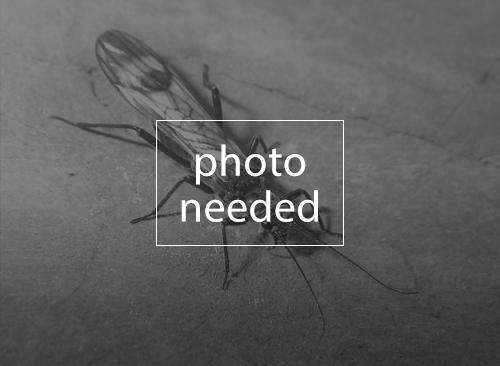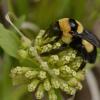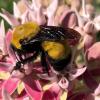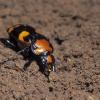
Hylaeus niloticus is a coastal and dry forest bee endemic to the islands of Molokai, Lanai, and Hawaii in Hawaii. It is similar to H. assimulans, distinguished by the smaller size, shape of the male scape, and other details. It has not been collected since 1918, and may be extinct.
Males
Face entirely yellow below the antennae, extending dorsally as narrow stripes along the eye; otherwise unmarked. Scape narrow, more than twice as long as wide, widest at apex.
Females
Entirely black, lacking coloration. Large, but without distinct punctation on the abdomen. Hylaeus niloticus is close to H. assimulans and H. ombrias in the flavipes species group.
Males can be separated by the shape of the scape, which is widest at the apex in H. niloticus and at the middle in the other two; both sexes of the former have the frons much more densely punctate. Hylaeus niloticus is also usually smaller, but small specimens of the others have been found.
Taxonomic Status
Hylaeus niloticus was described as Nesoprosopis obscurata by Perkins (1899). Nesoprosopis was reduced to a subgenus of Hylaeus by Meade-Waldo (1923). The name Prosopis nilotica was proposed by Warncke (1970) to resolve homonymy with Prosopis obscurata Schenck (Warncke considered Prosopis rather than Hylaeus the correct name for the genus). The most recent taxonomic treatment was Daly and Magnacca (2003).
Hylaeus niloticus has been collected from both coastal strand and higher-elevation dry forest. Little else is known about it. Nesting habits are unknown, but it probably nests in the ground like related species.
Historic collections of H. niloticus are from the leeward areas of Molokai, Lanai, and Hawaii. No recent collections exist.
Xerces Red List Status: Critically Imperiled (Possibly Extinct)
Other Rankings:
Canada – Species at Risk Act: N/A
Canada – provincial status: N/A
Mexico: N/A
USA – Endangered Species Act: Species of Concern
USA – state status: HI: Species of Concern
NatureServe: GNR
IUCN Red List: N/A
This species was found widely though not abundantly in the early period of Hawaiian insect collecting (1892-1930); it has not been collected in over 80 years and may be extinct. If it does exist, it is probably restricted to small, scattered populations.
The greatest threat to H. niloticus is habitat loss. Dry forest and coastal vegetation have been severely impacted by feral ungulates and invasive plants.
Several areas where H. niloticus may persist have not been investigated fully or at all. These include the southern slopes of East Molokai, much of Lanai, and montane dry areas of Kona on Hawaii. These areas, especially Molokai, should be checked for remnant populations of this species. Research is needed in order to locate populations and determine habitat requirements.
Daly, H. V., and K. N. Magnacca. 2003. Insects of Hawaii, Vol. 17: Hawaiian Hylaeus (Nesoprosopis) Bees (Hymenoptera: Apoidea). University of Hawaii Press, Honolulu. 234 pp.
Meade-Waldo, G. 1923. Hymenoptera, fam. Apidae, subfam. Prosopidae, fasc. 181. Pp. 1-45 in P. Wytsman (ed.), Genera Insectorum. L. Desmet-Verteneuil, Brussels.
Perkins, R. C. L. 1899. Hymenoptera, Aculeata. Pp. 1-115 in D. Sharp (ed.), Fauna Hawaiiensis, Vol. 1. Cambridge University Press, Cambridge, United Kingdom.
Warncke, K. 1970. Beitrag zur systematik und verbreitung der Biengattung Prosopis F. in der westpalaarktis (Hymenoptera, Apoidea, Colletidae). Bull. Rech. Agr. Gembloux. 5:745-768.
Citation
Magnacca, K. N. 2005. Species Profile: Hylaeus niloticus. In Shepherd, M. D., D. M. Vaughan, and S. H. Black (Eds). Red List of Pollinator Insects of North America. CD-ROM Version 1 (May 2005). Portland, OR: The Xerces Society for Invertebrate Conservation.
Profile prepared by Karl Magnacca, USGS-BRD, Kilauea Field Station





